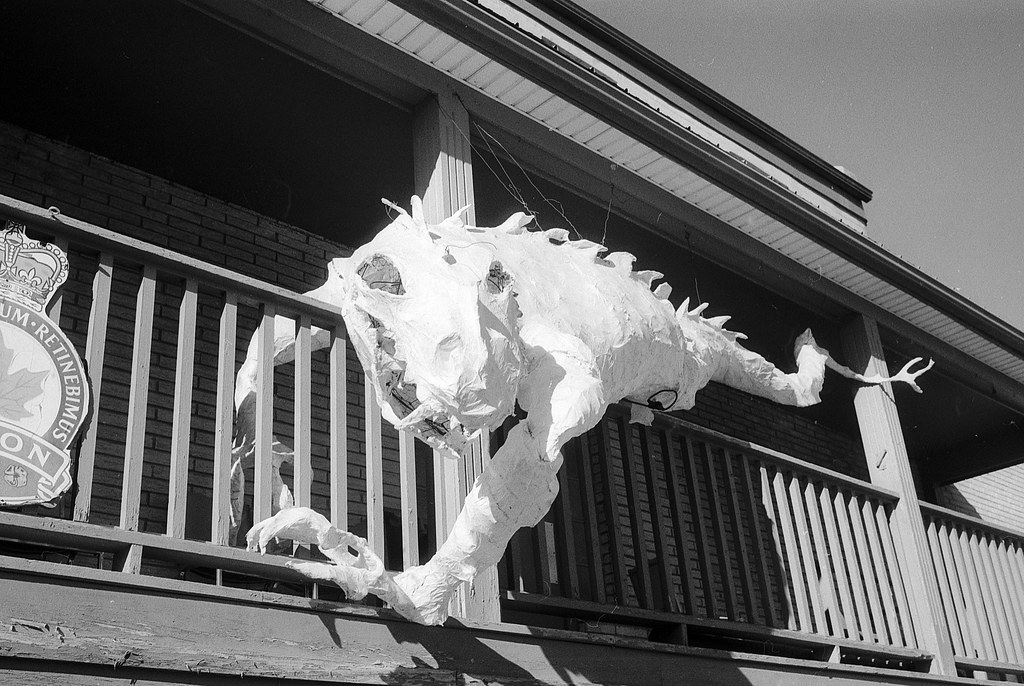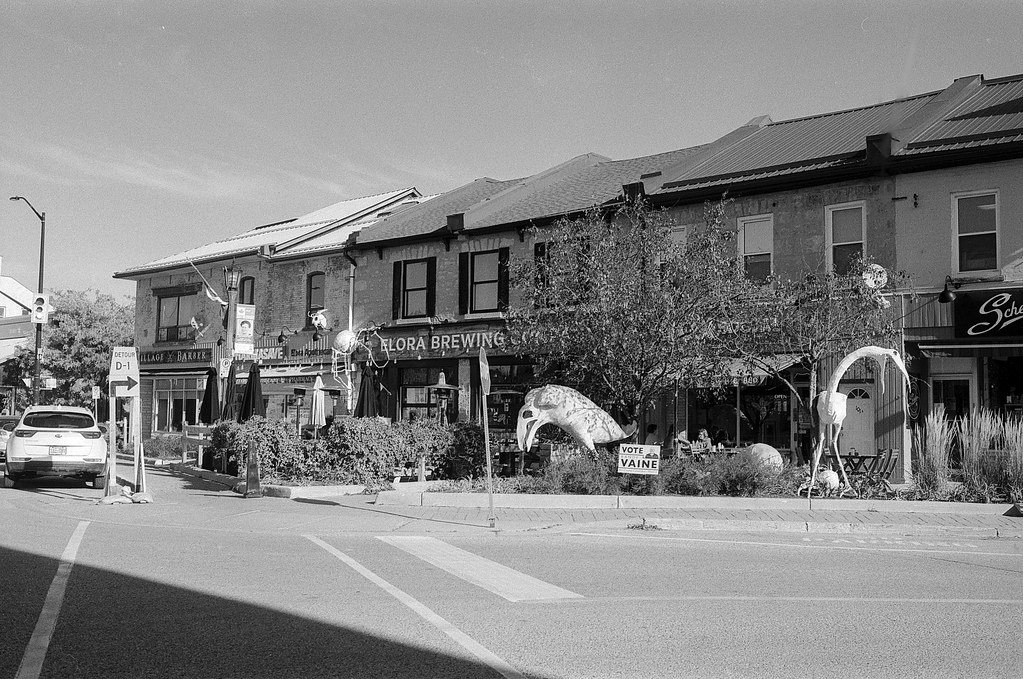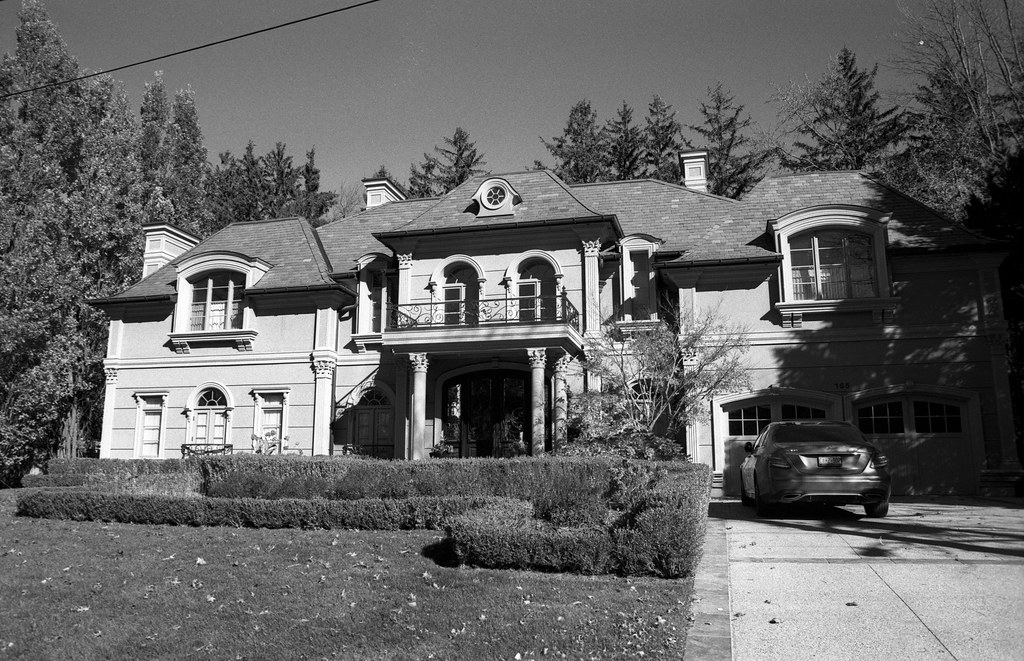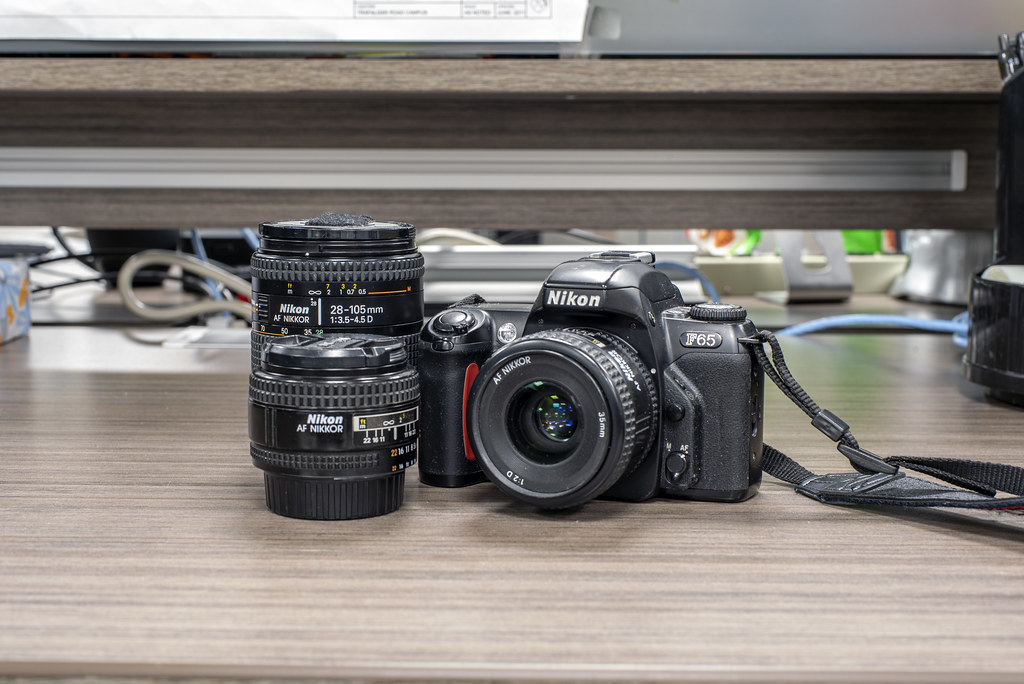Of late, I’ve had a soft spot for consumer-level SLRs. These are excellent options as knock-about cameras that often have the same internals as their professional cousins but in a smaller form factor and can be had for a low cost. The F65 is one of Nikon’s final entry-level SLRs and one of the best options for the era, as it combines form and functions and offers the greatest compatibility. While the F65 only saw production for a short period, its replacements split things into two sub-varients, a lower-spec F55 and a high-spec F75, the features on both are found in the F65. If you’re used to Nikon, especially their late 1990s and early 2000s SLRs, then the F65 is the perfect addition and backup for your Nikon AF kit. Thanks to Sherry Christiansen for this beautiful camera.
Camera Specifications
Make: Nikon
Model: F65 (Alternatively, N65 (USA) and U (Japan))
Type: SLR
Format: 135 (35mm), 36x24mm
Lens: Interchangeable, Nikon F-Mount
Shutter: Electronic Vertical Travel Focal Plane Shutter, 30″ – 1/2000″ + Bulb (1/2 Stop Increments)
Meter: TTL 6-Segment Matrix Metering, EV1 ~ EV20 @ ASA-100, ASA-25 – ASA-5000 (DX Only)
Autofocus: Nikon Multi-CAM900, 5-Point TTL Phase Detection, EV-1 ~ EV19 @ ASA-100
Dimensions (WxHxD): 139.5×92.5×65.5mm
Weight: 395g w/o batteries
Power Source: 2x 3V CR2 Batteries, Or 4x AA Batteries with optional MB-17 Battery Grip
Year of Manufacture: 2001-3 (Available until 2009)
Background
The F65 is the final entry-level SLR from Nikon after a fashion, but more later. The F65 offered a balance of affordability, ease of use, and functionality. Nikon’s earliest efforts to enter the consumer entry-level market were not always successful. While the first result, the Nikkorex line, was a nightmare, the Nikkormat proved an excellent balance. But the first try entry-level SLR came in 1979 with the Nikon EM. The EM was based on the small SLR form factor and was the first camera designed by noted Italian designer Girogetto Giugiaro. The EM, while officially marketed towards women, featured a fixed semi-automatic aperture priority exposure system, a 60/40 centre-weighted meter, and a mechanical backup shutter speed of 1/90″ and bulb. While production ceased in 1982, sales continued until 1984. The EM’s replacement, the FG, was a major improvement over the EM. The FG was the first full auto-exposure camera and included metered manual and aperture priority. On the FG, the program mode used a microprocessor that set the shutter speed when the aperture stopped before the shutter opened. The FG was only produced for two years and ceased the same year sales of the EM stopped, 1984. While Nikon did release the FG-20 that same year, it was a lower-spec camera. The first true replacement of the FG came in 1985 with the release of the F-301 (N2000); despite Minolta’s release of the Maxxum 7000 and 5000 with autofocus, the F-301 remained a manual focus camera. The F-301 featured a new polycarbonate body with a bulky, boxy shape that most cameras of the 1980s had; it also did away with a manual film advance opting for an in-body motorised advance system. It also used the new DX code system to automatically set film speeds. 1987’s F-401 finally introduced autofocus into Nikon’s consumer line of SLRs. The F-401 also added on-camera controls for both aperture and shutter speeds. In 1994 the F50 updated the overall look and feel of the camera; the F50 had a streamlined look compared to the previous models and also moved to a more button-based interface for all the camera’s functions. It also lacked the ability to use a remote release or have a depth-of-field preview option. In 1998, the F60 updated the overall look and added the single function dial and command dial. A moderate update in 2001 was the F65. The only difference between the 60 and 65 was the exterior looks and improved metering and autofocus modules. Production would end in 2003, but the F65 remained available until 2009. It was also in 2003 that Nikon split into upper and lower-tier entry-level SLRs, the F55 and F75.




Impressions
If you are familiar with the Nikon SLRs of this era, then the F65 will be no surprise. The F65 could even, at a quick glance, pass as some of the early consumer-level digital SLRs from Nikon or a scaled-down F80. With clean lines, a chunky grip and that iconic red highlight, the F65 is small, compact, and pretty feature rich for a camera of its calibre. When you pick the camera up, you can feel the solid build quality without added weight, and it has good balance even without the optional battery grip. Most of your shooting modes are centred around the main control dial; here, you can access the different exposure modes, fully automatic and creative options. The buttons allow for mid-roll rewind, EV compensation, and other adjustments. The one nice addition is separate on/off switch around the shutter release. There are a couple of noticeable omissions, the first being a second command dial for adjusting settings and a remote release port. The body is covered with a rubberised grip material, which has not turned sticky yet but does not feel the same as the material used on 1990s-era cameras. The F65 is not an exciting camera, but it has functionality and features where they count. And those are the ability for accurate autofocus and accurate metering, both of which the F65 delivers are all someone with an entry-level camera cares about.




Experiences
The F65 isn’t what I would consider a grab-and-go camera for an entry-level SLR. While I’m familiar with Nikon cameras, picking up the F65 was a no-brainer; coming from the F80 as my first Nikon AF SLR, the F65 looked and felt the same and even had a lot of the same functionality. But the one thing that threw me was loading up the batteries; I put them in the wrong way, and the F65 loads the battery opposite of how I thought. Once I had that fixed, I was off to the races. The film door and latch were solid and made from metal; the film loaded and advanced with the first shutter press. The one downside is that there is no option to manually set your film speed; the F65 sets the speed automatically from the DX code on the film canister, and if there is no DX code sets the speed to ASA-100. You can fudge this with the EV adjustment, but you are limited to a +/- two-stop over or under. But the average photographer using the F65 would not care about these adjustments. But I found it is far easier to work within the limitations than to make the camera do what you want. The viewfinder, while not 100%, is still bright and has plenty of displayed information, including the aperture, shutter speeds, and a frame counter. The autofocus, while loud, is accurate and decently fast even with the older AF and AF-D lenses, and the meter is excellent and always gets the best exposure. The lack of a second command dial is not an issue in Program mode and Shutter and Aperture priority modes, but the problem is when you go into the manual mode. Here is what I think, what Nikon was thinking. Usually, Nikon goes with Aperture priority in the forefront. But in the case of the F65, by default, the dial adjusts the shutter; you need to press and hold a button to adjust the aperture. And its placement is a bit awkward. The shutter release has a bit of a hair trigger, so you must be careful when doing that half-push to get the camera to focus and meter. I accidentally tripped the shutter several times, but at least the metering and autofocus were on point. Of course, that could be the copy of the camera I have; it’s not a bad thing, but something to be mindful of. You can do a mid-roll rewind of the film, but it is a two-button release, an added safety feature in the absence of a single recessed rewind button.




Optics
Like any Nikon SLR, the F65 features the standard F-Mount. And what, on paper, is the F65 compatible with mounting almost any Nikon lens? In practicality, that is not true. First, don’t attempt to mount non-AI lenses, as you will damage the lens mount on the camera. The F65 also cannot use manual focus lenses, so AI, AI-S and Series E. While they can be mounted, the camera will not be able to meter or read aperture, so you’re stuck in an un-metered manual, and with no rangefinder assist, either focusing might be difficult. But you can use any AF lens on the camera without any trouble. This includes the original AF, Type-D and Type-G. There is also full support for AF-S lenses, but avoid the DX-type lenses and the new Type-E. And while the AF Nikkor lenses can still be expensive, deals can be found. The original AF lenses are inexpensive even compared to the Type-D and only lack the ability to transmit the distance information to Nikon speedlights. You also have to watch out for size and weight. While I can mount my 28-70/2.8D and 14-24/2.8G, these are massive pieces of glass and will throw off the weight and balance of the camera body. The best lens to start off with is the 28-80 f/3.5-4.5G; you can get it in both silver and black finishes, and the kit lens came stock with the camera. While not the perfect piece of glass, it offers a decent quality to get you off the ground. The older 28-105mm f/3.5-4.5D is an excellent choice for something a little better.




Lowdown
The F65, for being an entry-level camera, offers a superb balance of form, function and affordability. You can easily pick up one of these cameras on the used market for under 100$, and sometimes it may even come with a third-party lens. But if you already have a collection of Nikon autofocus lenses, then you might be able to save some money and pick up a body alone. The biggest problem is that once the camera breaks, there’s not much available for repair. Best to purchase either another body or go up to the F75. The camera relies on a pair of CR2 batteries, which are not too expensive but are not readily available. You can pick up the optional MB-17 battery grip, which allows you to power the camera using four AA batteries instead. Despite having access to my F5 and Maxxum 9, the F65 fills a nice little niche in my kit, nothing too expensive and one that can still get the shot without fearing loss or damage. Plus, it makes for a good Frugal Film Project camera.
Further Reading
Don’t just take my word on the Nikon F65; you can check out the reviews by other awesome camera reviewers!
Austerity Photo – Oops, I did it Again! The Nikon F65/N65 Review
Ken Rockwell – Nikon N65/F65 Review
Filmbodies.com – Nikon N65 Review


Very informative. Breaks between paragraphs. I have two n 60s. N90.n90s. And an n2002. Most of them do not have a pc valve. I have to buy a portable hot shoe and hook my external flash to it . I also have an N 80. The biggest drawback for me is when I get the err after a while and have tried to fix it on one camera but to no avail. Otherwise they all take good photos.